You see story spoons all over social media these days, and rightly so, because they are beautiful aesthetic resource that can have a lot of value. But how do you get children to use them in a constructive way, and not just hit each other or have sword fights?
In short, how do you use story spoons? Story spoons require a lot of modelling to get children to use them in a positive way. You can start with simple adult-led story sessions, where children attempt to take on roles from a well-known story. The spoons can then be used in child-led play in a range of ways.
If you just create spoons and then put them into provision, it is unlikely to work very effectively. But follow the formula below, and you can expand your range of spoons into a fantastic and open-ended resource that can become a daily staple in your setting.
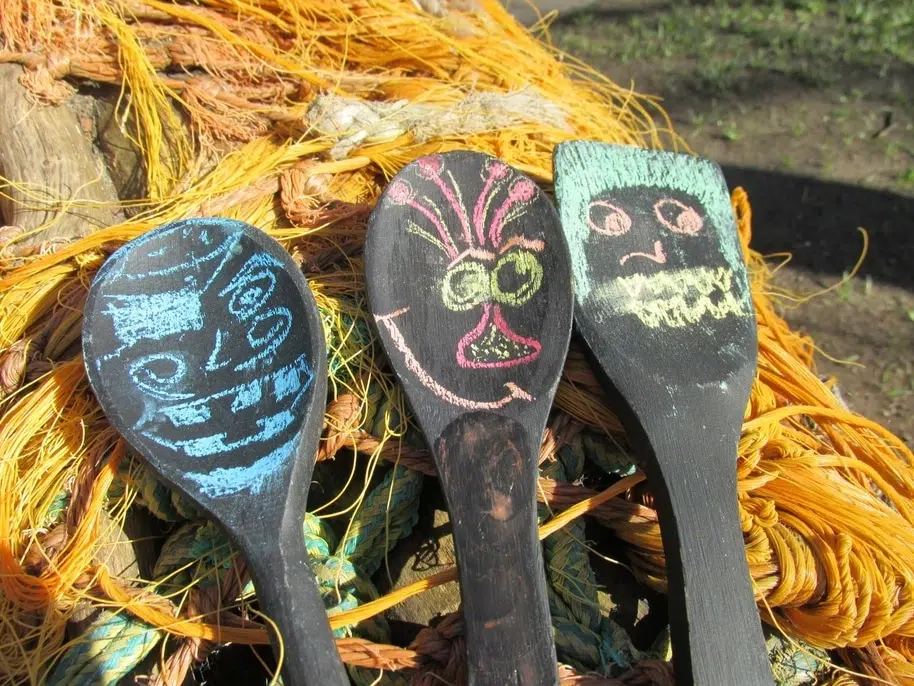
First, What Do Children Learn In Using Story Spoons?
Story spoons are one of the best resources for developing children into independent storytellers.
The benefits of becoming a ‘storyteller’ are huge, and include:
- To develop vocabulary
- To extend imagination
- To deepen their understanding and love of books
- To enrich their experience of play
- To extend ideas in play and link it to books
- To engage in sustained shared thinking
After the age of five, 80% of vocabulary is developed through stories. Therefore, those children that have a love and involvement in story in their play are well placed to develop in eloquence and confidence.
Right, now on with the strategies…
The Strategies
1. Use Them For Well-Known Refrains
My number one way of introducing story spoons for the first time is to use them in well-known refrains in stories.
For this you need quite a few spoons. It takes a bit of time to prepare them, but it is time well spent as it will get you off to a good start!
Use a book the children know well. Something with loads of repetition in is great. A good example, would be The Three Little Pigs.
You simply have lots of pig spoons and lots of wolf spoons. They don’t have to look incredible. Pretty much pink spoons with eyes, and brown spoons with eyes are fine. Even just drawing on the faces with a permanent marker is totally fine. It is not a photo shoot – it is an opportunity to learn.
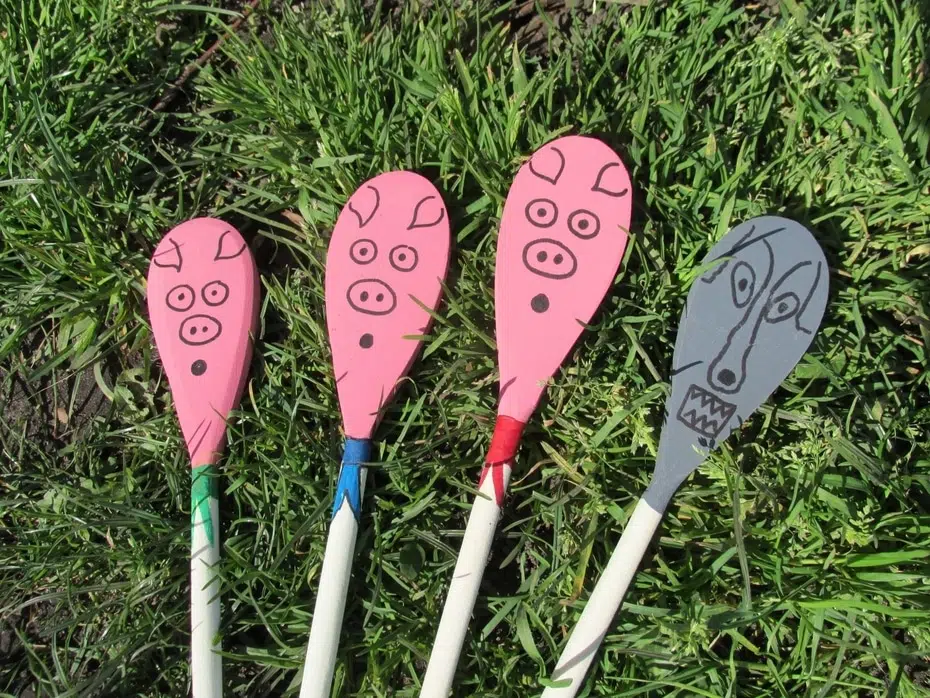
A quick note, is that I always use acrylic paint. To be honest I use for everything. It does not fade, it is water resistant, and it will look similar many years from now.
Show the children how to hold the spoons in front of their face.
Then chant a bit of the book.
For example, get the wolves all to say (in their best wolf voice) – ‘Little pig, little pig, let me in!’
Then the first little pigs will say – ‘Not by the hair on my chinny chin chin!’
Continue in this vein. You will probably have to do a bit of narrating to keep the whole thing going.
This simple but fun story session, is my number one way of getting them started.
Any book with a repeating refrain is also good for this. Think of books like Peace At Last, where Daddy Bear says ‘Oh no! I can’t stand this!’ at the end of every page. Use the spoons to say the refrain together, holding the in front of your faces.
This is also a brilliant activity to try out with rhythm sticks – hitting refrains in books to get used to the rhythm of words. If you’d like to find out many more rhythm sticks games, then take a look at my essential guide.
Even blank spoons is probably fine to get them started.
2. Interviews
This is another great fun adult-led strategy. Once tried out, it can also be extended into provision very simply.
All you need for this is some spoons and some sort of microphone. I like to use an old karaoke microphone, but even something that just looks like a microphone is fine. A hair-brush for example!
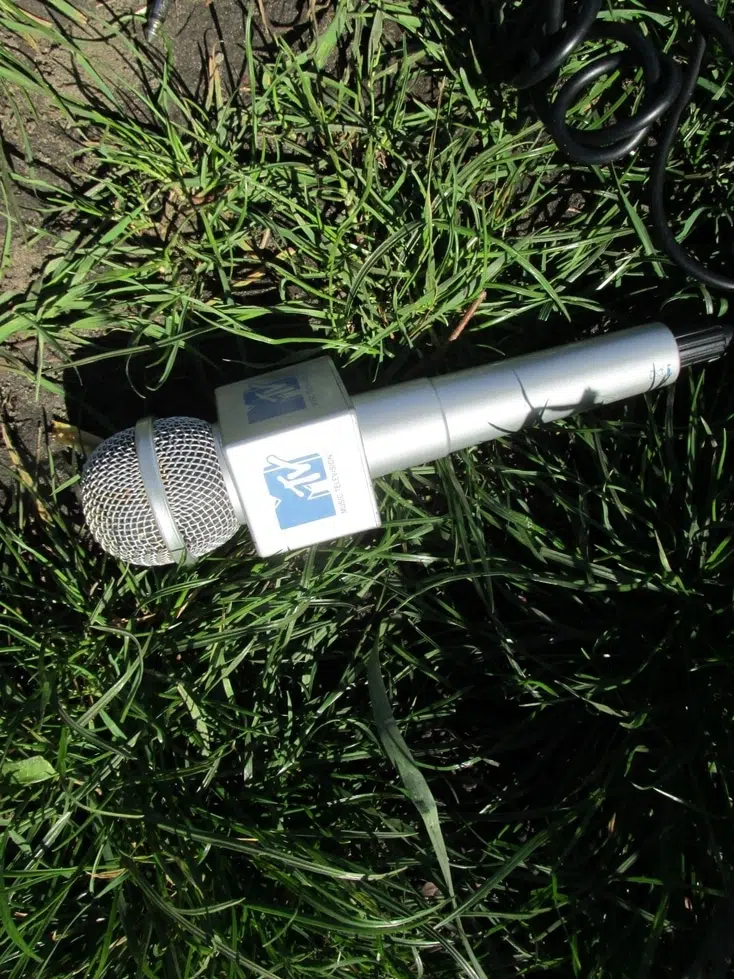
I would either start by modelling it on an adult, or at least on quite confident children, preferably ones with good language already. It is often a good idea to model something in the best possible way with more skilful children, to scaffold the others and just generally get you off to a good start.
I would normally start with some character spoons from a story they know really well.
You simply ask some questions of the characters. For example, if it is The Three Little Pigs, you can ask a pig, ‘What are you going to do today? What are you going to use to build your house with? Why have you chosen that? What do you think will happen?’
You could ask the wolf ‘What are you going to do? How will you blow down the brick house?’
Just make some things up and go along with what they say. Sometimes the children will deviate a long way from the story. This is all good. Reimagining narratives is a skill in itself.
If they do a funny character voice then that is even better.
This interview game can later be extended into continuous provision.
You can go over to children with the microphone and ask them some questions. This is great if they engaging with spoons, but can also be done without spoons. If they enjoying role-play or a small-world activity, then the interview technique works really well also.
Now that we have a bit of an idea how to use spoons, we will go on to some more child-led ways putting them into provision…
3. Character Spoons
This is the simplest introduction of spoons into provision. This takes a bit of painting usually.
I like to use acrylic paint, and a permanent marker for the outlines when they have dried.
Simply draw and paint some characters onto spoons, and put them into provision.
You have two choices. You can link the spoons to a book that they know well. For example, you can see the Whatever Next spoons that I created to go with that story. A bit of adult-led modelling again does help the process.
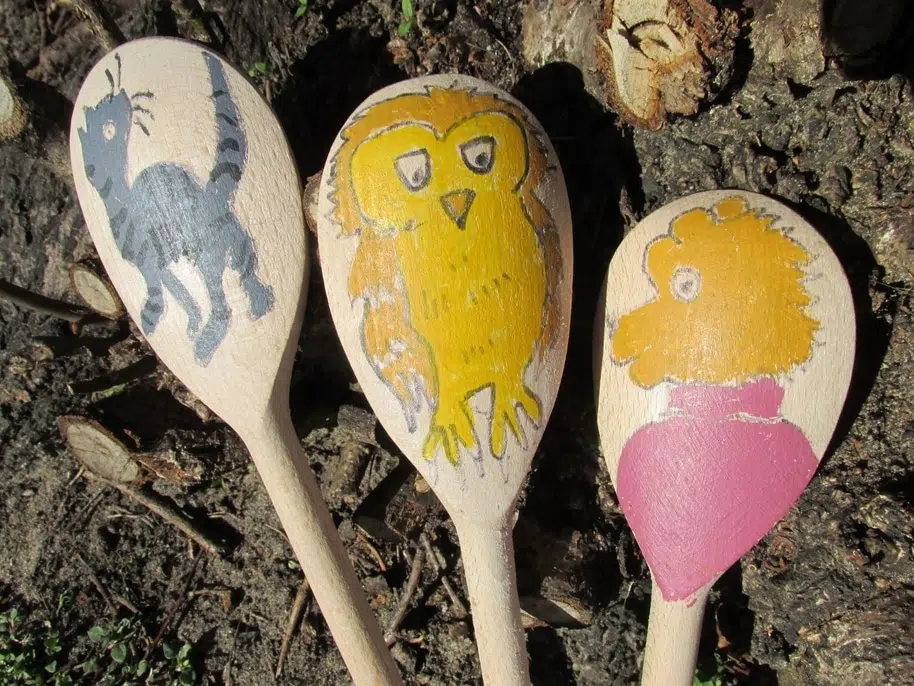
Alternatively, you can just paint on some random characters. For example, a ghost, a witch, a bear, a cat, a frog and a mouse.
This is a bit more open-ended, as the children can create their own voices, names, contexts, and narrative.
You can use story stones in a similar way for this activity. To read my complete guide to using story stones then click here.
And where do you put the spoons? Some good places are:
Into a role-play area, particularly if it is open-ended or deconstructed.
Into dens outside, or pleasant communication spaces.
In a reading space or den.
In a small world area, particularly if it has loose parts or open-ended objects
In a block area or construction area
4. Chalkboard Paint Spoons
This is possibly my favourite way to use story spoons. This makes them so open-ended and the children can take control of their learning.
I wouldn’t start the children out with this strategy, however. Get them used to character spoons first.
When they have an idea how to use them, then you can try these chalkboard spoons.
These are really quick and easy to make. Just get some spoons and paint them with one coat of chalkboard paint.
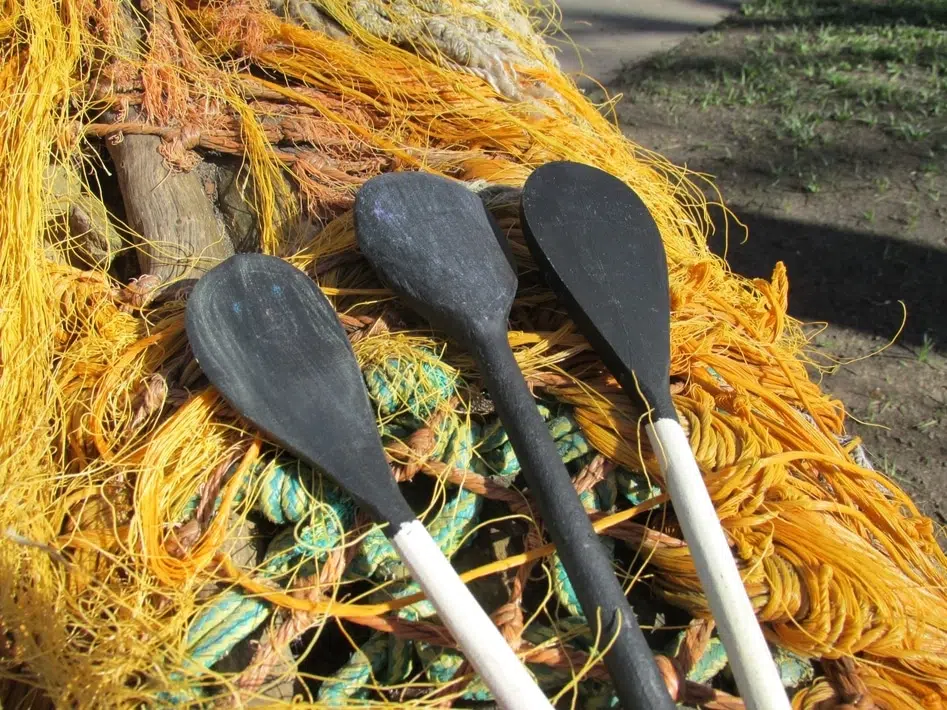
The children can then draw their own images on the spoons. They can draw characters from stories, or make them up. They can also draw settings or problems as well, though in my experience they normally go more for characters.

The world is their oyster, and they can come up with whatever character they like, give it a name, a voice, and engage in play using it.
5. Sensory Spoons
These are a beautiful hands-on version of the spoons. I got the idea for these from a fantastic blog on The Imagination Tree website.
To make these spoons, you superglue items onto the spoons to make them more sensory. For example, you can glue on cotton, wool, matchsticks, tin-foil, or material.
These materials give them a texture and touchability. They also suggest different things to spark the children’s imagination. For example, the cotton wool spoon could be a sheep, or santa, or a fluffy cloud.
The matchsticks could be a T-Rex’s teeth, or a bumpy road, or trees in a forest.
This is a bit abstract, and very open-ended, and really gets them all thinking.
6. Character, Setting, Problem, Resolution
You can use the spoons just like you would story stones, for making up magical stories. For this, you ideally need four types of spoons – ones with characters on, some with settings, and others with problems and resolutions.
Examples of these might be:
Character – Good characters such as a frog, a cat, a girl, a boy, a queen, a mouse and a robot.
Setting – This is somewhere to go in the story. Good examples are a spooky cave, a castle, the sea, an island, a forest.
Problem – These are the bad things that happen. Examples are a fire, a You can also have some bad characters, such as a ghost, a witch, a dragon and a wolf.
Resolution – These are good things that happen to resolve the problems. They could be things like a key, a letter, a ring, a superhero, and many other things. The resolution sometimes takes a bit of imagination, and you have to think how on earth the picture on the spoon can help in the story.
When you have a set of spoons with some of these pictures on, then you can have a go of creating a story.
The simplest way is just to put the spoons in a bag, and take them out one at a time. Get a child to take out a spoon, say a bit of the story, and then hand the bag to someone else.
This creates a random, meandering story, and is great for getting them excited about storytelling, and starting them off.
If you want to get a bit more structure into the stories, then the next step is to put the spoons into four baskets. The baskets will contain the spoons that link to character, setting, problem, resolution.
Then you simply take one spoon out of each basket and use them to help you tell a story.
Older children can begin to write this process down in either pictures or words.
7. Mixed With Loose Parts In Small World
Story spoons and loose parts go really well together.
I always set up tinker trays of loose parts in several areas, that look a bit like this:
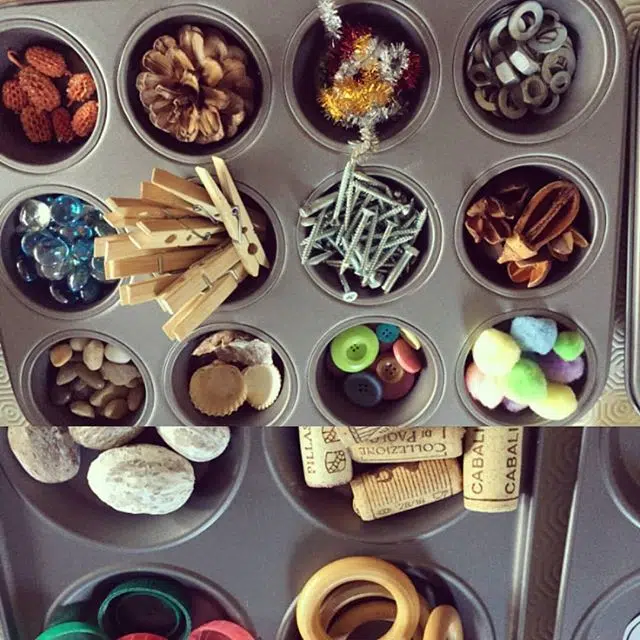
Good loose parts for this kind of play are things like pompoms, bottle tops, screws and bolts, conkers, pine-cones, wood slices, pegs, and gems.
Use can use character spoons with these, or more open-ended spoons such as the chalkboard or character suggestion.
The rough idea here is for the spoons to take on characters, and children to start playing and acting out a narrative of some sort. The loose parts then enhance that experience and bring it to life.
If you are not sure what sort of objects you could use for this kind of play, then check out my complete guide to the materials you can use for loose parts play with at least 100 ideas.
The items can from a backdrop, or setting. The pegs could be palm-trees, the conkers stepping stones over the swamp.
The bolts could be oars on the raft.
There is no right or wrong!
The more open-ended the better, and just see what they come up with.
Loose parts can be used to create characters to go with the spoons, or problems or resolutions. All parts of stories can be imagined.
To find out the full guide to the best 40 loose parts play ideas to do with kids then click here.
8. Character Suggestion Spoons
These are fantastic for getting the children really thinking.
The idea of these spoons is that you paint them all in quite a bland, simple colour. For example, I have painted mine white.
Then you just draw the suggestion of a character on them. For example, you might want to draw on a big mouth with spiky teeth, and nothing else on the spoon.
Or you could draw a pair of evil eyes, with a frowning forehead.

The big emphasis is on them being open-ended. The big mouth could be a dinosaur, or a monster, or a bear.
The evil eyes could belong to the Big Bad Wolf, or a witch, or a vampire.
The children just make it up! It gives them more freedom to invent a name, a character and bit of a persona.
Again, I would not start with these spoons first. Get the children used to character spoons first, and then these types of spoons are a next step.
9. Use Them In Play
One of the beauties of the spoons is that you can use them in several areas of the setting.
Some of the best include:
Block play – The children can create buildings for the characters to live in. They can build settings and landscapes, and engage in all sorts of other play.
Role-play – The spoons are great in role-play, where they can influence the narrative taken on by the children. They can often be involved in seriously random scenarios, where stories, reality and characters get intertwined.
Reading area – The experience of looking at stories can be greatly enhanced by the use of spoons. Children can read stories to the spoons, or get them to look at the pictures. They can act out stories with spoons and props.
Dens – Comfy enclosed areas are great for more private storytelling using spoons.
Small World play – This is the area I use spoons in the most. Great with some other props, or loose parts that either link with a character theme, or can be completely open-ended. For example, a few cogs, sticks and stones, and some blank spoons can be turned into any kind of drama imaginable.
10. Get Them to Make Their Own
Children of course always have a greater sense of ownership and pride in the resources if they have hand-crafted them themselves.
They are much more likely to respect an item if it is a part of them.
Spoons are cheap and plentiful, and are a great investment. Children can paint, glue, or craft their spoons in all manner of ways.
They can create characters of their own choice, and will usually be proud to bring them to life with a name, persona and back-story.
It is great for the different spoons to interact in a range of play.
Conclusion
So there you have it – all the ideas I can possibly think of to introduce story spoons successfully into your setting.
Story spoons take a bit of preparation, but once you have them it is a resource that will last for many years, and can become a part of daily provision.
Good luck with the story spoons, and please tell me about any of your own story spoon experiences in the comments below.
Related Questions
How do you use story stones? Paint a range of characters, settings, problems and resolutions onto stones. Put the stones in a bag, and let the children take one at a time out randomly and tell a story. To get more structure into the story, put the stones into four baskets that match the four types of stones. To find out more about how to use story stones, you can read The Essential Guide On How To Use Story Stones.
What storytelling strategies are there in the early years? Stories can be brought to life with props or story sticks. You can use props such as story stones or story-boxes to bring stories to life. Children learn to tell stories by having stories read to them often, and by digesting their content.
Anywhere else I can find out about story spoons? Juliet Robertson’s fantastic outdoor learning blog has a brilliant article about an outdoor art project where children turned spoons into characters and then the spoons were hung from trees. Well worth a read – Wooden Spoons At The Coombes School
How do you make story spoons? The simplest way is to buy cheap wooden spoons from a hardware store. Use acrylic paint, particularly if you want them to last well and be water-resistant. Paint the spoons to look like characters, either from a story or not.
